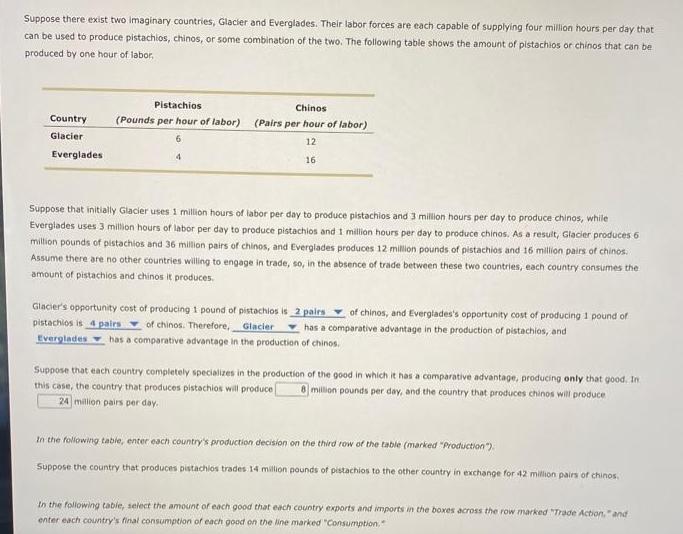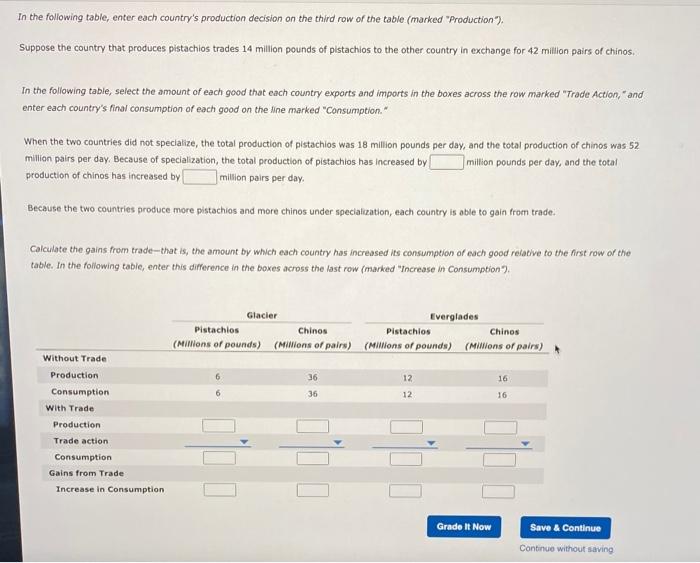Answered step by step
Verified Expert Solution
Question
1 Approved Answer
Suppose there exist two imaginary countries, Glacier and Everglades. Their labor forces are each capable of supplying four million hours per day that can


Suppose there exist two imaginary countries, Glacier and Everglades. Their labor forces are each capable of supplying four million hours per day that can be used to produce pistachios, chinos, or some combination of the two. The following table shows the amount of pistachios or chinos that can be produced by one hour of labor. Country Glacier Everglades Pistachios Chinos (Pounds per hour of labor) (Pairs per hour of labor) 12 16 Suppose that initially Glacier uses 1 million hours of labor per day to produce pistachios and 3 million hours per day to produce chinos, while Everglades uses 3 million hours of labor per day to produce pistachios and 1 million hours per day to produce chinos. As a result, Glacier produces 6 million pounds of pistachios and 36 million pairs of chinos, and Everglades produces 12 million pounds of pistachios and 16 million pairs of chinos. Assume there are no other countries willing to engage in trade, so, in the absence of trade between these two countries, each country consumes the amount of pistachios and chinos it produces. Glacier's opportunity cost of producing 1 pound of pistachios is 2 pairs of chinos, and Everglades's opportunity cost of producing 1 pound of pistachios is 4 pairs of chinos. Therefore, Glacier has a comparative advantage in the production of pistachios, and Everglades has a comparative advantage in the production of chinos. Suppose that each country completely specializes in the production of the good in which it has a comparative advantage, producing only that good. In this case, the country that produces pistachios will produce 8 million pounds per day, and the country that produces chinos will produce 24 million pairs per day. In the following table, enter each country's production decision on the third row of the table (marked "Production"). Suppose the country that produces pistachios trades 14 million pounds of pistachios to the other country in exchange for 42 million pairs of chinos. In the following table, select the amount of each good that each country exports and imports in the boxes across the row marked "Trade Action," and enter each country's final consumption of each good on the line marked "Consumption." In the following table, enter each country's production decision on the third row of the table (marked "Production"). Suppose the country that produces pistachios trades 14 million pounds of pistachios to the other country in exchange for 42 million pairs of chinos. In the following table, select the amount of each good that each country exports and imports in the boxes across the row marked "Trade Action," and enter each country's final consumption of each good on the line marked "Consumption." When the two countries did not specialize, the total production of pistachios was 18 million pounds per day, and the total production of chinos was 52 million pairs per day. Because of specialization, the total production of pistachios has increased by million pounds per day, and the total production of chinos has increased by million pairs per day. Because the two countries produce more pistachios and more chinos under specialization, each country is able to gain from trade. Calculate the gains from trade-that is, the amount by which each country has increased its consumption of each good relative to the first row of the table. In the following table, enter this difference in the boxes across the last row (marked "Increase in Consumption"). Without Trade Production Consumption With Trade. Production Trade action Consumption Gains from Trade Increase in Consumption Glacier Pistachios Chinos (Millions of pounds) (Millions of pairs) 36 36 Everglades Pistachios Chinos (Millions of pounds) (Millions of pairs) 12 12 Grade It Now 16 16 Save & Continue Continue without saving
Step by Step Solution
★★★★★
3.40 Rating (162 Votes )
There are 3 Steps involved in it
Step: 1
Complete the table based on the information provided Without Trade Glaciers Production Pistachios 6 million pounds Chinos 36 million pairs Evergladess ...
Get Instant Access to Expert-Tailored Solutions
See step-by-step solutions with expert insights and AI powered tools for academic success
Step: 2

Step: 3

Ace Your Homework with AI
Get the answers you need in no time with our AI-driven, step-by-step assistance
Get Started


